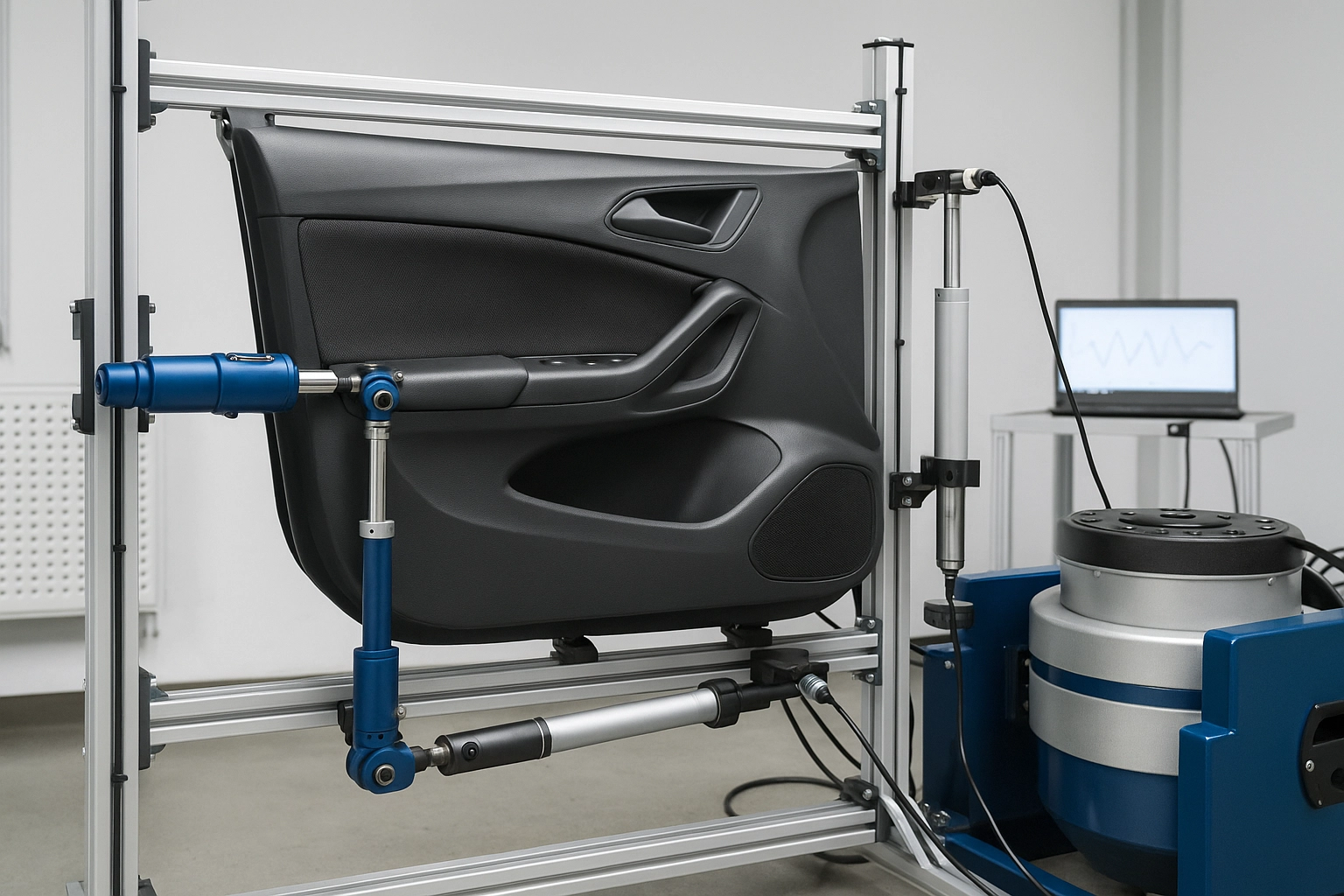ASTM E756 Laminated Panel BSR Damping Test
The ASTM E756 test method is a crucial procedure used in the automotive sector to evaluate the effectiveness of damping materials and their ability to reduce unwanted noises such as buzz, squeak, and rattle (BSR). This testing ensures that automotive interiors are quiet and comfortable for passengers. The primary goal here is to assess the sound absorption characteristics of materials like viscoelastic foams, rubbers, or composites used in vehicle interiors.
The test involves placing a laminated panel between two plates that are then vibrated at specific frequencies. This setup allows the testing apparatus to measure the energy absorbed by the material over time. The absorption coefficient is calculated and compared against industry standards to determine compliance with automotive noise requirements.
ASTM E756 is widely used in R&D environments where new materials are being developed for sound insulation applications within vehicles. It helps quality managers and compliance officers ensure that their products meet or exceed the stringent acoustic performance criteria set by international standards like ISO 11204:2018.
The testing procedure is highly technical, involving precise control over environmental conditions such as temperature and humidity to ensure consistent results. Specimens are cut into standard sizes before being bonded together using specific adhesives. The bonding process is critical since poor attachment can lead to inaccurate absorption measurements.
Once the specimens have been prepared, they are placed between two plates within a sound chamber. A shaker excites one plate at various frequencies while the other plate measures the force transmitted through the specimen. This setup allows for the calculation of the damping factor (D), which quantifies how much energy is dissipated as heat rather than being re-radiated.
Compliance with ASTM E756 requires careful attention to detail throughout every stage of testing, from specimen preparation to data analysis. Non-compliance can result in substandard products that fail to meet customer expectations or regulatory requirements. Therefore, thorough quality assurance measures are essential during all phases of the testing process.
For instance, improper bonding techniques might cause variations in test results, leading to misleading conclusions about material performance. To mitigate this risk, laboratories adhering to ASTM E756 must employ trained personnel equipped with advanced equipment capable of delivering accurate measurements. Additionally, maintaining strict adherence to standard operating procedures ensures consistent outcomes across multiple tests.
In summary, the ASTM E756 test plays a vital role in ensuring that automotive components are acoustically optimized for optimal performance and passenger comfort. By utilizing this method, manufacturers can develop innovative solutions tailored specifically towards meeting current market demands while also preparing themselves for future challenges posed by increasingly stringent regulations.
Applied Standards
The ASTM E756 standard is based on several international guidelines including ISO 11204:2018, which provides additional context for the testing procedure. This international standard specifies procedures for measuring sound absorption coefficients of materials used in various industries, including automotive interiors.
ASTM E756 focuses specifically on laminated panels made from viscoelastic foams or similar materials designed to dampen noise caused by vibrations. These materials are often employed in seats, carpets, and other interior components where reducing BSR is paramount for improving passenger experience.
The standard outlines detailed steps for preparing specimens, setting up the testing apparatus, and interpreting results accurately. Compliance with these guidelines ensures that manufacturers produce consistent products capable of meeting both current and future acoustic performance expectations.
Scope and Methodology
The ASTM E756 scope encompasses a comprehensive approach to evaluating the damping properties of laminated panels used in automotive interiors. The test aims to quantify how well these materials absorb sound energy, thereby reducing unwanted noises like buzz, squeak, and rattle.
During testing, specimens are clamped between two plates within a controlled environment designed to simulate real-world conditions accurately. A shaker applies sinusoidal vibrations at different frequencies across the entire frequency range of human hearing (20 Hz - 20 kHz). Simultaneously, sensors measure both transmitted and reflected sound waves.
The resulting data is processed using specialized software that calculates key parameters such as damping factor (D) and absorption coefficient. These metrics provide insight into how effectively the material dissipates vibrational energy rather than re-radiating it back into the environment.
Environmental and Sustainability Contributions
The ASTM E756 test has significant implications for environmental sustainability by promoting quieter vehicles that contribute less noise pollution to urban environments. Quieter cars also enhance overall road safety since they allow drivers to hear external sounds more clearly, reducing accidents caused by distraction or misjudgment.
Additionally, the use of advanced damping materials like those evaluated in this test helps extend component lifetimes by minimizing mechanical stress and wear associated with prolonged exposure to vibration. This not only reduces waste but also decreases manufacturing costs over time as fewer replacements are needed due to premature failure.
By adhering to ASTM E756 standards, automotive manufacturers can contribute positively towards global efforts aimed at reducing carbon footprints through more efficient designs and materials selection processes.





